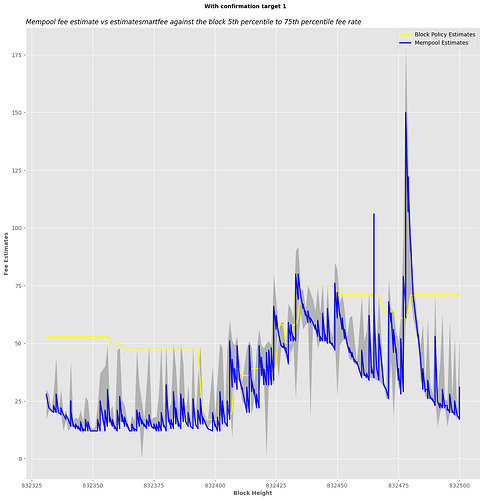I’ve updated to a format that is more interesting to look at. Thanks to additional data from @ClaraShk , I’ve filled between the 5th percentile fee rate to the 75th percentile fee rate.
Overall, based on my observations, using the threshold is not as much of an underestimation as I thought it would be. For most cases, estimates fall within the target block fee rate 5th percentile to 75th percentile range.
And I also calculated the summary of my observation:
Total of 19,154 estimates were made from 2024-02-28 01:57:56 to 2024-03-12 13:23:05 (Block 832330 to Block 834362)
CBlockPolicyEstimator::estimatesmartfee (economic mode) with confirmation target 1
5,643estimates overpaid, accounting for29.46%of the total estimates2,114estimates underpaid, accounting for11.04%of the total estimates11,397estimates fall within the range, accounting for59.50%of the total estimates
Mempool based estimate for next block (Without Threshold)
10estimates overpaid, constituting0.05%of the total estimates3,637estimates underpaid, constituting18.99%of the total estimates15,507estimates fall within the range, constituting80.96%of the total estimates
Mempool estimate for next block (With threshold of CBlockPolicyEstimator::estimatesmartfee (economic mode) confirmation target 1)
6estimates overpaid, constituting0.03%of the total estimates5,070estimates underpaid, constituting26.47%of the total estimates14,078estimates fall within the range, constituting73.50%of the total estimates
Using 5th percentile as the low end and 75th Percentile as the high end.
You can view it on Collab and edit the block ranges; it has a range threshold of 200 blocks:
Or run the notebook from the repository GitHub - ismaelsadeeq/fee-estimates-analysis and run the notebook.
